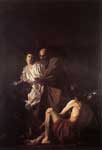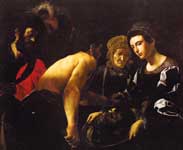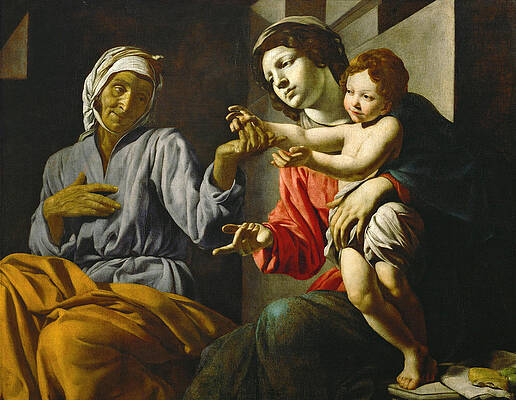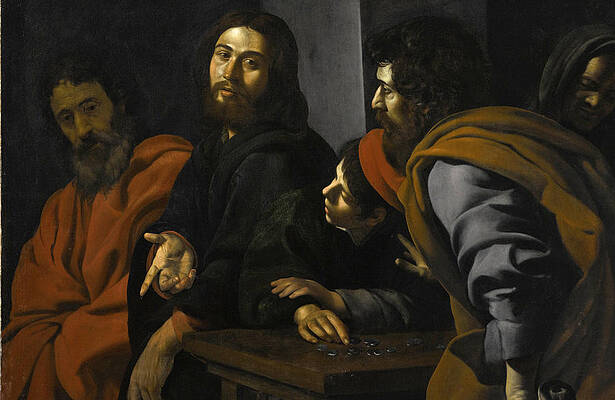Battistello (Giovanni Battista Caracciolo)
Paintings
Christ on the Mount of Olives. Christ's Fear of Death
Saint Mary with Child and Saint Anne
Two youths with grapes
The Calling of Saint Matthew



Drawings

Fine Art Prints | Greeting Cards | Phone Cases | Lifestyle | Face Masks | Men's , Women' Apparel | Home Decor | jigsaw puzzles | Notebooks | Tapestries | ...
Giovanni Battista Caracciolo (also called Battistello) (1578–1635) was an Italian artist and important Neapolitan follower of Caravaggio.
Early life
The only substantial early source of biography is that of Bernardo de' Dominici's unreliable publication of 1742.[1] De Dominici's statements are often contradicted by documented facts and others cannot be substantiated independently.[2][c] Archival documents state Caracciolo was born in Naples and baptised on 7 December 1578, as the son of Cesare Caracciolo and his wife Elena. The family lived in the parish of San Giovanni Maggiore.[2]
On 3 August 1598, at the age of twenty, Caracciolo married Beatrice de Mario. They had ten children, of whom eight survived to adulthood.[2][d]
Caravaggesque phase
The Liberation of St Peter. Pio Monte della Misericordia, Naples. Regarded as Battistello's masterpiece, it vividly captures the emotion of the scene as Peter is led from prison by an angel.
His initial training was said to be with Francesco Imparato and Fabrizio Santafede, but the first impulse that directed his art came from Caravaggio's sudden presence in Naples in late 1606.[3] Caravaggio had fled there after killing a man in a brawl in Rome, and he arrived at the end of September or beginning of October 1606.[4] His stay in the city lasted only about eight months, with another brief visit in 1609/1610, yet his impact on artistic life there was profound.
Caracciolo, only five years younger than Caravaggio, was among the first there to adopt the startling new style with its sombre palette, dramatic tenebrism, and sculptural figures in a shallow picture plane defined by light rather than by perspective. He is considered to be the solitary founder of the Neapolitan school of Caravaggism.[5] Among the other Neapolitan Caravaggisti were Giuseppe Ribera,[e] Carlo Sellitto, Artemisia Gentileschi, and Caracciolo's pupil, Mattia Preti, then early in his career.
Caracciolo's Caravaggesque phase was fundamental to his entire career. His first contact with Caravaggio must have been around the time of the Radolovich commission, dated 6 October 1606, and the contacts continued through Caravaggio's completion of the Seven Works of Mercy during the last months of that year and early 1607. A notable result of Caravaggio's influence is Caracciolo's The Crucifixion of Christ, with its strong echoes of the Crucifixion of Saint Andrew.[6]
In 1607, he painted the Immaculate Conception for the Santa Maria della Stella in Naples.[7]
In 1612, he made a trip to Rome.[8] A work showing the influence of this visit, and especially that of Orazio Gentileschi, is the Liberation of Saint Peter (1615), painted for the Pio Monte della Misericordia,[8] to hang next to Caravaggio's Seven Works of Mercy painted for the same church.[f] By this time he had become the leader of the new Neapolitan school, dividing his time between religious subjects (altarpieces and, unusually for a Caravaggist, frescos) and paintings for private patrons.
After 1618 he visited Genoa, Rome and Florence. In Rome he came under the influence of the revived Classicism of the Carracci cousins and the Emilian school, and began working towards a synthesis of their style with his own tenebrism - his Cupid, with its bravura handling of the red cloth, shows the influence of the Carracci synthesis. Back in Naples, he translated this into grandiose, wide-ranging scenes frescos including his masterpiece Christ Washing the Feet of the Disciples of 1622, painted for the Certosa di San Martino.[3] He also painted further works in the Certosa di San Martino, Santa Maria La Nova and San Diego all'Ospedaletto and these works of the late second decade of the 17th century onward, show the strong influence of Bolognese classicism he might have been exposed to in Rome.[5]
He died in Naples, in the few days between creating his last will, on 19 December 1635, and 24 December 1635, when it was opened and read.[2]
Notes
Using date of baptism.
Using date of baptism and the day before the reading of his will.
Benedetto Croce referred to De Dominici as 'il Falsario'
De Dominici claimed Caracciolo never married and was childless.
On 3 May 1626, Caracciolo and Ribera are witnesses to the wedding of Giovanni Do[2]
The Liberation is now in the Museo di Capodimonte in Naples.
References
de' Dominici, Bernardo (1742). Vite dei Pittori, Scultori, ed Architetti Napolitani (in Italian). Napoli: Nella Stamperia del Ricciardia. pp. 273–291.
Stoughton, Michael (April 1978). "Giovanni Battista Caracciolo: New Biographical Documents". The Burlington Magazine 120 (901): 204, 206–213, 215. Retrieved 12 July 2013.
Salinger, Margaretta (January 1937). "Christ and the Woman of Samaria by Caracciolo". The Metropolitan Museum of Art Bulletin 32 (1): 4–6. Retrieved 12 July 2013.
Pacelli, Vincenzo (December 1977). "New Documents concerning Caravaggio in Naples". The Burlington Magazine 119 (897): 819–827, 829. Retrieved 12 July 2013.
Wittkower, Rudolf (1999). Art and Architecture in Italy, 1600-1750: The High Baroque, 1625-1675, Volume 2. Yale University Press. ISBN 9780300079401.
Pacelli, Vincenzo (August 1978). "Caracciolo Studies". The Burlington Magazine 20 (905): 493–497, 499. Retrieved 12 July 2013.
Pérez Sánchez, Alfonso E.; Spinosa, Nicola (1992). Jusepe de Ribera, 1591-1652. New York: The Metropolitan Museum of Art. ISBN 9780870996474. Retrieved 13 July 2013.
Spinosa, Nicola (2012). "Neapolitan Painters in Rome (1600-1630)". In Rossella Vodret. Caravaggio's Rome: 1600-1630 (paperback). Milan: Skira Editore S.p.A. p. 338. ISBN 9788857213873.
Bibliography
Bryan, Michael (1886). Robert Edmund Graves, ed. Dictionary of Painters and Engravers, Biographical and Critical (Volume I: A-K). York St. #4, Covent Garden, London; Original from Fogg Library, Digitized May 18, 2007: George Bell and Sons. p. 230.
Ben Nicolson, Caravaggism in Europe, Oxford, 1979, 2e ed., dl.I, p. 74-77
Wittkower, Rudolf (1980). Art and Architecture Italy, 1600-1750. Penguin Books. pp. 356–358.
Ferdinando Bologna (Herausgeber) Battistello Caracciolo e il primo naturalismo a Napoli, Ausstellungskatalog Castel San Elmo, Chiesa della Certosa di San Martino, 1991/92
Stefano Causa Battistello Caracciolo: L'Opera Completa 1578-1635,Neapel 2000 (Causa promovierte über Battistello an der Universität Neapel: Ricerche su Battistello Caracciolo 1994/95)
Nicola Spinosa u.a. Tres Siglos de Oro de la Pintura Napolitana. De Battistello Caracciolo a Giacinto Gigante, Ausstellungskatalog, Museum der Schönen Künste Valencia 2003/4, Ed. Caja Duero, 2003
---
Fine Art Prints | Greeting Cards | Phone Cases | Lifestyle | Face Masks | Men's , Women' Apparel | Home Decor | jigsaw puzzles | Notebooks | Tapestries | ...
---
Artist
A - B - C - D - E - F - G - H - I - J - K - L - M -
N - O - P - Q - R - S - T - U - V - W - X - Y - Z
Retrieved from "http://en.wikipedia.org/"
All text is available under the terms of the GNU Free Documentation License







